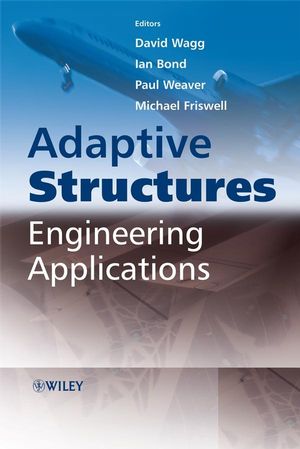Adaptive Structures: Engineering ApplicationsISBN: 978-0-470-05697-4
Hardcover
314 pages
July 2007
 |
||||||
List of Contributors xi
Preface xvii
1 Adaptive Structures for Structural Health Monitoring 1
Daniel J. Inman and Benjamin L. Grisso
1.1 Introduction 1
1.2 Structural Health Monitoring 4
1.3 Impedance-Based Health Monitoring 6
1.4 Local Computing 8
1.5 Power Analysis 11
1.6 Experimental Validation 13
1.7 Harvesting, Storage and Power Management 18
1.7.1 Thermal Electric Harvesting 19
1.7.2 Vibration Harvesting with Piezoceramics 22
1.8 Autonomous Self-healing 25
1.9 The Way Forward: Autonomic Structural Systems for Threat Mitigation 27
1.10 Summary 29
Acknowledgements 30
References 30
2 Distributed Sensing for Active Control 33
Suk-Min Moon, Leslie P. Fowler and Robert L. Clark
2.1 Introduction 33
2.2 Description of Experimental Test Bed 35
2.3 Disturbance Estimation 36
2.3.1 Principal Component Analysis 36
2.3.2 Application of PCA: Case Studies 37
2.3.3 Combining Active Control and PCA to Identify Secondary Disturbances 40
2.4 Sensor Selection 43
2.4.1 Model Estimation 45
2.4.2 Optimal Sensor Strategy 45
2.4.3 Experimental Demonstration 48
2.5 Conclusions 55
Acknowledgments 56
References 56
3 Global Vibration Control Through Local Feedback 59
Stephen J. Elliott
3.1 Introduction 59
3.2 Centralised Control of Vibration 61
3.3 Decentralised Control of Vibration 63
3.4 Control of Vibration on Structures with Distributed Excitation 67
3.5 Local Control in the Inner Ear 76
3.6 Conclusions 84
Acknowledgements 85
References 85
4 Lightweight Shape-Adaptable Airfoils: A New Challenge for an Old Dream 89
L.F. Campanile
4.1 Introduction 89
4.2 Otto Lilienthal and the Flying Machine as a Shape-Adaptable Structural System 91
4.3 Sir George Cayley and the Task Separation Principle 93
4.4 Being Lightweight: A Crucial Requirement 95
4.5 Coupling Mechanism and Structure: Compliant Systems as the Basis of Lightweight Shape-Adaptable Systems 104
4.5.1 The Science of Compliant Systems 104
4.5.2 Compliant Systems for Airfoil Shape Adaptation 113
4.5.3 The Belt-Rib Airfoil Structure 115
4.6 Extending Coupling to the Actuator System: Compliant Active Systems 118
4.6.1 The Need for a Coupled Approach 118
4.6.2 Solid-State Actuation for Solid-State Deformability 120
4.6.3 Challenges and Trends of Structure–Actuator Integration 123
4.7 A Powerful Distributed Actuator: Aerodynamics 125
4.7.1 The Actuator Energy Balance 125
4.7.2 Balancing Kinematics by Partially Recovering Energy from the Flow 125
4.7.3 Active and Semi-Active Aeroelasticity 126
4.8 The Common Denominator: Mechanical Coupling 127
4.9 Concluding Remarks 128
Acknowledgements 129
References 129
5 Adaptive Aeroelastic Structures 137
Jonathan Cooper
5.1 Introduction 137
5.2 Adaptive Internal Structures 142
5.2.1 Moving Spars 143
5.2.2 Rotating Spars 147
5.3 Adaptive Stiffness Attachments 152
5.4 Conclusions 159
5.5 The Way Forward 160
Acknowledgements 161
References 162
6 Adaptive Aerospace Structures with Smart Technologies – A Retrospective and Future View 163
Christian Boller
6.1 Introduction 163
6.2 The Past Two Decades 165
6.2.1 SHM 167
6.2.2 Shape Control and Active Flow 170
6.2.3 Damping of Vibration and Noise 173
6.2.4 Smart Skins 176
6.2.5 Systems 177
6.3 Added Value to the System 179
6.4 Potential for the Future 185
6.5 A Reflective Summary with Conclusions 186
References 187
7 A Summary of Several Studies with Unsymmetric Laminates 191
Michael W. Hyer, Marie-Laure Dano, Marc R. Schultz, Sontipee Aimmanee and Adel B. Jilani
7.1 Introduction and Background 191
7.2 Room-Temperature Shapes of Square [02/902]T Cross-Ply Laminates 193
7.3 Room-Temperature Shapes of More General Unsymmetric Laminates 198
7.4 Moments Required to Change Shapes of Unsymmetric Laminates 200
7.5 Use of Shape Memory Alloy for Actuation 206
7.6 Use of Piezoceramic Actuation 210
7.7 Consideration of Small Piezoceramic Actuators 216
7.8 Conclusions 228
References 228
8 Negative Stiffness and Negative Poisson’s Ratio in Materials which Undergo a Phase Transformation 231
T.M. Jaglinski and R.S. Lakes
8.1 Introduction 231
8.2 Experimental Methods 234
8.2.1 Material Preparation 234
8.3 Composites 236
8.3.1 Theory 236
8.3.2 Experiment 237
8.4 Polycrystals 238
8.4.1 Theory 238
8.4.2 Experimental Results 239
8.5 Discussion 244
References 244
9 Recent Advances in Self-Healing Materials Systems 247
M.W. Keller, B.J. Blaiszik, S.R. White and N.R. Sottos
9.1 Introduction 247
9.1.1 Microcapsule-Based Self-Healing 248
9.1.2 Critical Issues for Microencapsulated Healing 250
9.2 Faster Healing Systems – Fatigue Loading 251
9.3 Smaller Size Scales 253
9.4 Alternative Materials Systems – Elastomers 256
9.5 Microvascular Autonomic Composites 258
9.6 Conclusions 259
References 260
10 Adaptive Structures – Some Biological Paradigms 263
Julian F.V. Vincent
10.1 Introduction 263
10.2 Deployment 264
10.3 Turgor-Driven Mechanisms 266
10.3.1 The Venus Fly Trap 270
10.3.2 Previous Theories 271
10.3.3 Background to an Elastic Model 271
10.3.4 The Trigger 273
10.4 Dead Plant Tissues 274
10.5 Morphing and Adapting in Animals 276
10.6 Sensing in Arthropods – Campaniform and Slit Sensilla 277
10.7 Developing an Interface Between Biology and Engineering 279
10.7.1 A Catalogue of Engineering 279
10.7.2 Challenging Engineering with Biology 280
10.7.3 Adaptive Structures – The TRIZ Route 282
10.7.4 Materials and Information 283
10.8 Envoi 285
Acknowledgements 285
References 285
Index 289



